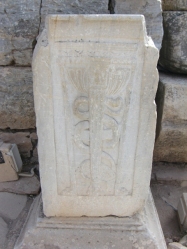
It is important to note. Although we are now on the coastal strip of Anatolia, we are far from the northern stretch where a famous city stood. The one towards which a thousand ships were supposedly launched to attack. Just to retrieve one person. In fact we are 380km by road from that city. That’s because we started from Denizli if you had read about our mini adventure to the cotton cascades here.

Ephesus, located at the south-western coast of Turkey is both historically and culturally important. As with Istanbul, we were here on two separate occasions though this is the combined account. Of Biblical significance due to St Paul’s letters, the city demonstrated how advancement and decadence had crept into society by these late Roman times during which the apostle lived.
This ancient city was established as a port and used to be the most important commercial centre in this part of the Aegean due to its strategic location. The city was abandoned over time as the harbours silted up and left behind wastes of salt and marsh with the sea now 10km away. When excavated, many structures were found still intact. And till this day the city has not been fully excavated, since it was very large. Perhaps it is good not to disturb all that remains under the earth, and today as one strolls the tourist path one can see numerous examples of columns that were found and still not put together (it’s a complex puzzle).
The city was one of many former Greek and Phoenician colonies that grew on trade of wine and exotic goods from the east.  And it was considered big for its time – about 250,000 (a metropolis back then) people in all were said to have lived here! The streets were paved and wide, like our multi-lane highways perhaps for lots of horse and donkey traffic… living their lives and
And it was considered big for its time – about 250,000 (a metropolis back then) people in all were said to have lived here! The streets were paved and wide, like our multi-lane highways perhaps for lots of horse and donkey traffic… living their lives and
Living on a prayer
Our first stop was at the House of the Virgin Mary. Many pilgrims come to this site to pay their respects. Our guide told us that the one thing that many young Turkish women do here is to make a wish. It goes like this:
- Lighting a candle
- Drinking the holy water
- Tying a knot of the written wish
Critical to do this in the correct sequence in order that the wish will come true. Many are said to be looking for a good husband… may we add: a wise, wealthy and devoted one too!
We saw numerous clay pipes lying on the ground. These once formed the piped system of supplying water to the city. 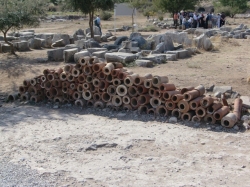 Imagine the power and wealth of the city that is manifested in the way it is organized – such as its infrastructure. Having piped water to your home almost 2000 years ago, does that not make real estate in this city coveted? Today we when we assess the standard of living of a city on such yardsticks too don’t we?
Imagine the power and wealth of the city that is manifested in the way it is organized – such as its infrastructure. Having piped water to your home almost 2000 years ago, does that not make real estate in this city coveted? Today we when we assess the standard of living of a city on such yardsticks too don’t we?
 We next visited the Odeon, where the senate of the city convened regular meetings for town business. Aside from political discourse, the Basilica also served as a small theatre. Unfortunately not much is left of that. Walking through the Basilica, we came into the Domitian Square. This was the site of the temple that was dedicated to the emperor. There we found carvings, that were to form the basis for the representation of the medical profession. Do you recognize them?
We next visited the Odeon, where the senate of the city convened regular meetings for town business. Aside from political discourse, the Basilica also served as a small theatre. Unfortunately not much is left of that. Walking through the Basilica, we came into the Domitian Square. This was the site of the temple that was dedicated to the emperor. There we found carvings, that were to form the basis for the representation of the medical profession. Do you recognize them? 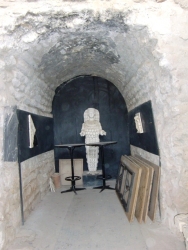 Ephesus was thus not only a commercial centre, it attracted some of the best talents from across the arts and science – including medical experts. Recall the emblem of the medicine at the start of the essay?
Ephesus was thus not only a commercial centre, it attracted some of the best talents from across the arts and science – including medical experts. Recall the emblem of the medicine at the start of the essay?
The city leadership often bent in the direction of political winds, frequently changing loyalties with the wane and rise of different powers. 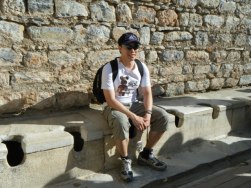 One such incident involved the city seceding to Mithridates of the Pontic Empire, only to return to the Roman fold for favourable taxation terms. Talk about being mercantilist!
One such incident involved the city seceding to Mithridates of the Pontic Empire, only to return to the Roman fold for favourable taxation terms. Talk about being mercantilist!
Here you will see Mel sitting on one of the many public latrines in the city – there is not much privacy here now but back in the day it was policy for folks to wash their hands and keep themselves clean. Obviously the city elders were clinical about the health of the city folk too.
The temple of Hadrian is one of the best preserved and most beautiful structures. It was built around the year 138 by Quintilius and was dedicated to the Emperor Hadrian. Oh we love those arches, for they surely look better than modern yellow one… but the sight that one cannot miss when coming to Ephesus would be
Borrowing some scrolls from the library
As one walk along the colonnaded way one will finally came to the highlight of the site – the library of Celsus. It was built in the year 117 and originally meant to be a mausoleum for Gaius Julius Celsus Polemaeanus (breathe), the governor of the province of Asia. It came from his son Galius Julius Aquila but was turned to a library by some twist of fate.  You see, the local authorities banned cemeteries to be built within the city at that time, so the building was donated to the city instead and turned into a place of study. At its height, the library contained more manuscripts than any other in the western world – more than 12,000 scrolls it is said, which made it the third richest library in ancient times after the Alexandra and Pergamum. Wow. Mel would have fancied being a librarian (and scribe) here if he had lived in those times.
You see, the local authorities banned cemeteries to be built within the city at that time, so the building was donated to the city instead and turned into a place of study. At its height, the library contained more manuscripts than any other in the western world – more than 12,000 scrolls it is said, which made it the third richest library in ancient times after the Alexandra and Pergamum. Wow. Mel would have fancied being a librarian (and scribe) here if he had lived in those times.
Take note of the statues in the niches of the columns. They symbolize wisdom (Sophia), knowledge (Episteme), intelligence (Ennoia) and valor (Arete). Inside the Library is a statue of Athena over the grave of Celsus, as Athena is the Goddess of wisdom. Can you spot them?
The final stop is the theatre, located near the former harbor on a hill slope. This is southern entrance to the city and once had capacity for 25,000 people. From here one can see Arcadian way which in ancient times led to the harbour. It was said that Marc Anthony and Cleopatra walked down this road along the Arcadian way after disembarking. Re-enact this with your own princess, it’s not cliché.
Nearby are the ruins of the temple of Artemis, now only its foundations remain as you can see in the photo. Most of the remains are now housed in the London British museum and we can only imagine what it looked like.  In the background is Selcuk fortress, a Byzantine defence structure that the Ottomans enlarged. We did not visit that site.
In the background is Selcuk fortress, a Byzantine defence structure that the Ottomans enlarged. We did not visit that site.
Then it was onward drive towards Söke and the temple of Apollo at Didyma. It is a sanctuary where the oracle of Apollo was located. Indeed, so strong was the belief that when the Persians carried away the archaic bronze statue of Apollo, the oracle spoke no more for a century until Seleucus brought it back.  If it can be found now, what would it say? When we explored the temple, we could see that it was extremely large as evident with the size of the columns. Here a thought : while at Delphi (Greece) the oracle only spoke while at Didyma the oracle would write in prose or riddle for the recipient. All the same, people all through the ages had always been curious about their futures. Are you?
If it can be found now, what would it say? When we explored the temple, we could see that it was extremely large as evident with the size of the columns. Here a thought : while at Delphi (Greece) the oracle only spoke while at Didyma the oracle would write in prose or riddle for the recipient. All the same, people all through the ages had always been curious about their futures. Are you?
Well, that’s all for this page. For this journey continued on towards the southern coastline of Turkey. Read here for our journey towards the Turkish Riviera.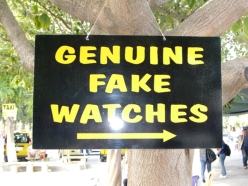
This Journey took place in August 2003 (Ephesus only) and October 2010
Talk about telling the truth… How you not respond to a sign like this? Marketers, take note and learn.





















Nice post, I enjoyed reading it and it gave me a memory nudge. Thanks!
LikeLiked by 1 person
Oh wow! And we have yet to introduce this page yet! Heheh… did you spent time along the coast of Turkey? How long ago?
LikeLike
We were in Turkey in 2014. Three weeks on the coast but with various trips inland. Liked it but for the appalling litter everywhere!
LikeLiked by 1 person